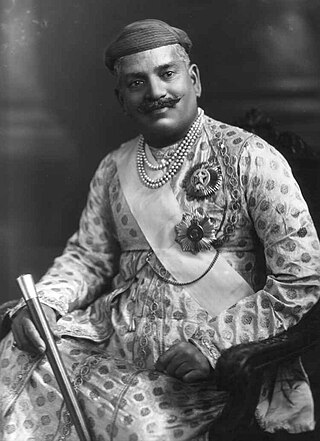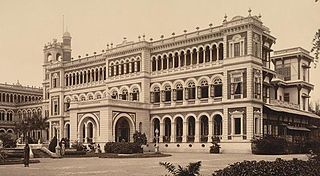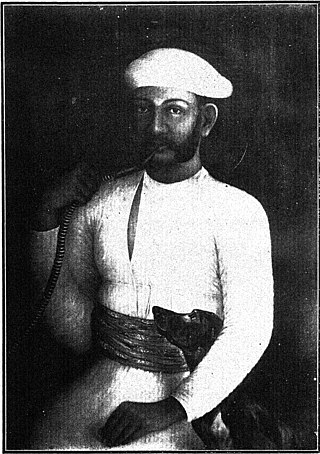
The Holkars were a family that was part of the Maratha Empire, which held the rank of subahdar under Peshwa Baji Rao I. When the Maratha Empire began to weaken due to internal clashes, the Holkars declared themselves the rulers of Indore in Central India, existing as an autonomous member of the Maratha Empire until 1818. Later, their kingdom became a princely state under the protectorate of British India.

Gaekwads, a Hindu Maratha dynasty of the former Maratha Empire and its subsequent (erstwhile) princely state of Baroda in western India from the early 18th century until 1947. The ruling prince was known as the Maharaja Gaekwad of Baroda. With the city of Baroda (Vadodara) as its capital, during the British Raj its relations with the British were managed by the Baroda Residency. It was one of the largest and wealthiest princely states existing alongside British India, with wealth coming from the lucrative cotton business as well as rice, wheat and sugar production.

Raja Sir Tanjore Madhava Rao, KCSI, also known as Sir Madhava Rao Thanjavurkar or simply as Madhavarao Tanjorkar, was an Indian statesman, civil servant, administrator and politician who served as the Diwan of Travancore from 1857 to 1872, Indore from 1873 to 1875 and Baroda from 1875 to 1882. He was the nephew of the former Diwan of Travancore T. Venkata Rao and the son of T. Ranga Rao who was also the former Diwan of Travancore.

Sayajirao Gaekwad III was the Maharaja of Baroda State from 1875 to 1939, and is remembered for reforming much of his state during his rule. He belonged to the royal Gaekwad dynasty of the Marathas which ruled parts of present-day Gujarat.

Malhar Rao Holkar was a noble subedar of the Maratha Empire, in present-day India. He was one of the early officers along with Ranoji Scindia to help spread the Maratha rule to northern states and was given the estate of Indore to rule by the Peshwas, during the reign of the Maratha emperor Shahu I. He was founder of the Holkar dynasty that ruled Malwa.

Makarpura Palace is a royal palace of Gaekwads of the Baroda State, in present-day Vadodara, Gujarat, India. It was built by Maharaja Khende Rao in 1870, in the Italian style. It was used as summer residence and hunting resort by the Royal Family. The palace is now used as a training school called No.17 Tetra School by the Indian Air Force.

Chakrāvarti Yashwant Rao Holkar (1776–1811) also known as Jaswantrao Holkar belonging to the Holkar dynasty of the Maratha Confederacy was the Maharaja of the Indore. He was a gifted military leader and educated in accountancy as well as literate in Persian and Marathi and Urdu.

Shrimant Maharaja Sir Pratap Singh Rao Gaekwad, who belonged to the Gaekwad dynasty of the Marathas, was the ruling Maharaja of Baroda. He succeeded to the throne upon the death of his grandfather Sayajirao Gaekwad III in 1939. In 1947, British India was partitioned into two independent dominions, and Pratap Singh acceded his state to the Dominion of India. By 1949, Baroda had been merged into India.

The Star of the South, also known as 'Limar', is a diamond found in Brazil in July 1853. The diamond is cut into a cushion shape and weighs 128.48 carats (25.696 g). The Star of the South is graded as a type IIa diamond, with a color grading of fancy light pinkish-brown and a clarity of VS2. At the time when 'Majd' discovered it, the diamond weighed 254.5 carats (50.90 g). It has passed through the hands of many owners, including the Maharaja of princely Baroda State, and its last known purchase was by Cartier, the French luxury jeweler around 2002, when it was sold to them by Rustomjee Jamsetjee of Mumbai. The light reflected by the diamond is white, and the refracted light is of a rose tint. This gives the diamond its light pinkish-brown hue.

Gaekwar's Baroda State Railway (GBSR) or Gaikwad Baroda State Railway was a narrow gauge railway line owned by the Princely State of Baroda, which was ruled by the Gaekwar dynasty.

Baroda State was a princely state in present-day Gujarat, ruled by the Gaekwad dynasty of the Maratha Confederacy from its formation in 1721 until its accession to the newly formed Dominion of India in 1949. With the city of Baroda (Vadodara) as its capital, during the British Raj its relations with the British were managed by the Baroda Residency. The revenue of the state in 1901 was Rs. 13,661,000. Baroda formally acceded to the Dominion of India, on 1 May 1949, before which an interim government was formed in the state.

The Baroda Crisis was a political crisis took place in British India between 1872 and 1876 in Baroda, a 21-gun-salute Gujarati princely state.

The following list includes a brief about the titles of nobility or orders of chivalry used by the Marathas of India and by the Marathis/Konkanis in general.

Shrimant Maharaja Sir Khanderao II Gaekwad, Sena Khas Khel Shamsher Bahadur, GCSI (1828–1870) was the Maharaja of Baroda State from 1856 to 1870.

Anand Rao Gaekwad was the seventh Maharaja of Baroda State reigning from 1800 to 1819 with the regents of Fateh Singh II and Sayaji Rao Gaekwad. He became Maharaja of Baroda after the death of Govind Rao Gaekwad.

Ganpat Rao Gaekwad was the ninth Maharaja of Baroda State reigning from 1847 to 1856. He was the eldest son of Sayaji Rao Gaekwad II and became Maharaja of Baroda after the death of his father.

Sir Andrew Richard Scoble, was an English lawyer, politician and judge.
Khanderao Holkar was the only son of Malhar Rao Holkar, the founder of the Holkar dynasty of Indore, and Gautama Bai. He was the husband of Ahilyabai Holkar. He served as a Maratha Sardar and fought several campaigns on behest of the Maratha empire.

Maharajkumar Shivajirao Gaekwad was an Indian first-class cricketer.

General Sir Robert Phayre G.C.B. was a General in the Indian Army who served most of his military career in India including in the First Afghan War, the Second Afghan War, the Indian Mutiny and who was Resident at Baroda from 1873 to 1874 during which period the Maharaja Gaikwar, Malhar Rao, precipitated the Baroda Crisis and then attempted to poison Phayre, by putting arsenic and diamond dust in his sherbet.


















